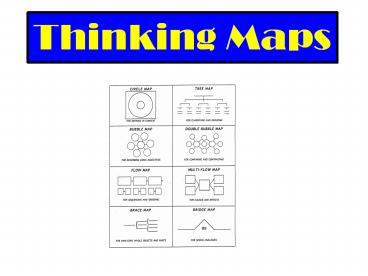Thinking Maps - PowerPoint PPT Presentation
Title:
Thinking Maps
Description:
Talk politely. Actions at a Safe School. No bullying. Have a buddy with you ... Being polite. sharing. Helping others 'Be There' Good attitude toward others. No ... – PowerPoint PPT presentation
Number of Views:2130
Avg rating:3.0/5.0
Title: Thinking Maps
1
Thinking Maps
2
What are Thinking Maps?
- Thinking Maps are eight visual-verbal learning
tools, each based on a fundamental thinking
process and used together as a set of tools for
showing relationships. Thinking Maps give all
students and teachers a common language for
meaningful learning.
3
Honey Islands Goal for Using Thinking Maps
- Our goal for student use of Thinking Maps is for
all students to learn the eight maps and the
thinking processes which they represent. Once
learned, we want the students to be able to apply
the maps across all subjects and activities,
applying the maps to assist them in organizing
their thinking. We also want students to
utililze the maps as a way to organize their
writing.
4
The Eight Maps
- Please refer to the title slide for pictures of
the eight maps. They include - Circle Map Defining in Context
- Bubble Map Describing Qualities
- Double Bubble Map Comparing and Contrasting
- Tree Map Classifying
- Brace Map Part-Whole
- Flow Map Sequencing
- Multi-Flow Map Cause and Effect
- Bridge Map Seeing Analogies
5
Circle Map
- The Circle Map is used for Brainstorming ideas
and for showing prior knowledge about a topic.
The center circle represents the topic. The
outside circle will contain written or drawn
information about the topic. In the following
examples, students brainstormed and defined
topics related to school safety.
6
No fighting
No drugs
Protect school property
Stay out of school kitchen
No weapons
No name calling
Always have a buddy
Safe School
Children playing nicely
Follow the rules
Teachers teaching and students learning
Helping each other
No littering
No running
Get good grades
Follow directions
Using CHAMPS
Practice FISH
7
Use a zero voice when walking in the hall
Use kind words
Greet people nicely!
No bad words
Use respectful words!
Conversationat a Safe School
No lying
No bullying words!
Tell an adult if you see something unsafe
Before first bell - 1 voice, after first bell
0 voice
Follow CHAMPS
Talk politely
Raise your hand!
Zero voice when someone is speaking
8
Have fun!
No bullying
Listen to the teacher
Have a buddy with you
No running in the hall
Keep all personal things at home, like CDs,
games, etc.
Do not bring weapons, drugs, matches, or cell
phones
Follow Champs
Actions at a Safe School
Use appropriate language
Stay in personal space
Use FISH!
Stay in school safety zone
Help your friends!
Respect school property
Follow expectations everywhere!
Be there!
9
Drugs or medicine
Bows and arrows
weapons
matches
guns
lasers
knives
Cell phones
Pocket knives
alcohol
Items Not to Bring to School
Cigarette lighters
Video games and players
BB Gun
fireworks
Toys (unless for show and tell)
Box cutters
No radio or iPods
No pets
No cough drops
10
Be friendly to new people
Being polite
Be There
sharing
Good attitude toward others
Helping others
No bullying
Use FISH!
Having fun
A Friendly School
No weapons
No drugs
Be nice!
Make Their Day
Dont leave anyone out!
Play with everyone
Follow school expectations
Give Compliments
Help the substitutes
Listen to others!
Standing up for others
11
Dont destroy school property
Do not steal
Do not bully others
Dont fight
No spitting
Dont use bad language
Do not be disrespectful to teachers/adults
Things NOT to do at School
Dont scream at the teacher
Do not litter
Dont bring guns, cigarettes, drugs, knives,
brass knuckles, alcohol, or matches
No teasing
No pushing in line
No pulling the fire alarm!
Do not disobey the teachers































